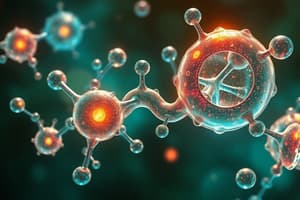Podcast
Questions and Answers
What class of enzyme is represented by the enzyme commission number 2.7.1.1?
What class of enzyme is represented by the enzyme commission number 2.7.1.1?
- Oxidoreductases
- Hydrolases
- Ligases
- Transferases (correct)
Which type of specificity is illustrated by chymotrypsin, which hydrolyzes peptide bonds near aromatic amino acids?
Which type of specificity is illustrated by chymotrypsin, which hydrolyzes peptide bonds near aromatic amino acids?
- Group specificity (correct)
- Linkage specificity
- Absolute specificity
- Stereochemical specificity
What is the primary role of an enzyme in a chemical reaction?
What is the primary role of an enzyme in a chemical reaction?
- To consume energy during the reaction
- To increase the rate of the reaction (correct)
- To change the substrates into products
- To alter the equilibrium of the reaction
Which factor does NOT affect enzymatic activity?
Which factor does NOT affect enzymatic activity?
In the reaction coordinate diagram, the activation energy is characterized by which of the following?
In the reaction coordinate diagram, the activation energy is characterized by which of the following?
What is the role of enzymes in chemical reactions?
What is the role of enzymes in chemical reactions?
Which of the following statements about enzymes is incorrect?
Which of the following statements about enzymes is incorrect?
What term describes a complete active enzyme with its bound cofactor or coenzyme?
What term describes a complete active enzyme with its bound cofactor or coenzyme?
Which of the following best describes cofactors?
Which of the following best describes cofactors?
Which class of enzymes catalyzes the transfer of functional groups from one substance to another?
Which class of enzymes catalyzes the transfer of functional groups from one substance to another?
What distinguishes a prosthetic group from a cofactor or coenzyme?
What distinguishes a prosthetic group from a cofactor or coenzyme?
How do enzymes contribute to biological processes compared to non-biological catalysts?
How do enzymes contribute to biological processes compared to non-biological catalysts?
What characteristic of enzymes is primarily related to their specificity?
What characteristic of enzymes is primarily related to their specificity?
Which enzyme class is responsible for hydrolysis reactions?
Which enzyme class is responsible for hydrolysis reactions?
What type of reaction do ligases catalyze?
What type of reaction do ligases catalyze?
Which of the following enzymes would be classified as an isomerase?
Which of the following enzymes would be classified as an isomerase?
Which of the following is an example of a transferase?
Which of the following is an example of a transferase?
What distinguishes lyases from other enzyme classes?
What distinguishes lyases from other enzyme classes?
Which reaction best illustrates the action of oxidoreductases?
Which reaction best illustrates the action of oxidoreductases?
Identify the primary function of hydrolases in the digestive system.
Identify the primary function of hydrolases in the digestive system.
Which enzyme example is classified as a ligase?
Which enzyme example is classified as a ligase?
Which statement correctly describes the effect of enzymes on reaction rates?
Which statement correctly describes the effect of enzymes on reaction rates?
What is the role of activators in enzyme activity?
What is the role of activators in enzyme activity?
How do enzymes generally bind to substrates according to the induced fit model?
How do enzymes generally bind to substrates according to the induced fit model?
Which enzyme listed has the highest rate enhancement?
Which enzyme listed has the highest rate enhancement?
What type of enzyme inhibitor permanently binds to an enzyme?
What type of enzyme inhibitor permanently binds to an enzyme?
What effect does a higher activation energy have on a reaction rate?
What effect does a higher activation energy have on a reaction rate?
Which statement is true regarding the 'lock and key' model of enzyme action?
Which statement is true regarding the 'lock and key' model of enzyme action?
What happens to an enzyme's activity if its metal ion activators are removed?
What happens to an enzyme's activity if its metal ion activators are removed?
What is the effect of competitive inhibitors on the Vmax and Km of an enzyme?
What is the effect of competitive inhibitors on the Vmax and Km of an enzyme?
Which type of inhibition only binds to the enzyme-substrate complex?
Which type of inhibition only binds to the enzyme-substrate complex?
What characterizes allosteric enzymes?
What characterizes allosteric enzymes?
Which of the following statements is true about mixed inhibition?
Which of the following statements is true about mixed inhibition?
Which enzyme isoenzyme is primarily associated with myocardial infarction?
Which enzyme isoenzyme is primarily associated with myocardial infarction?
What happens to the levels of creatine phosphokinase (CPK) following a muscle injury?
What happens to the levels of creatine phosphokinase (CPK) following a muscle injury?
What distinguishes isoenzymes from regular enzymes?
What distinguishes isoenzymes from regular enzymes?
In which manner do allosteric modulators affect enzyme activity?
In which manner do allosteric modulators affect enzyme activity?
What is the primary role of regulatory enzymes in metabolic pathways?
What is the primary role of regulatory enzymes in metabolic pathways?
Flashcards are hidden until you start studying
Study Notes
Enzymes
- Enzymes are biological catalysts that speed up reactions
- Enzymes are effective in small amounts, very efficient
- Enzymes do not affect the reaction equilibrium, but increase reaction rates.
- Most, but not all, enzymes are globular proteins.
- Enzymes work under mild conditions of temperature and pH.
- Some enzymes require cofactors
- Coenzymes are complex organic or metalloorganic molecules bound to an enzyme
- Apoprotein is the protein part of a holoenzyme, and the Holoenzyme is the complete active enzyme with its coenzyme and cofactors
- Enzymes are classified into six classes, each with subclasses:
- Oxidoreductases catalyze oxidation-reduction reactions
- Transferases transfer functional groups between molecules
- Hydrolases break down molecules by hydrolysis
- Lyases break down molecules, but not by hydrolysis
- Isomerases rearrange atoms within a molecule
- Ligases join two molecules together
- Enzymes show specificity:
- Absolute specificity means an enzyme acts only on one substrate
- Stereochemical specificity means an enzyme acts only on one stereoisomer
- Linkage specificity means an enzyme acts on a specific bond, regardless of neighboring groups
- Group specificity means an enzyme acts on a specific linkage and also requires neighboring groups
- Factors affecting enzymatic activity include:
- Enzyme concentration, substrate concentration, temperature, and pH.
- The active site of an enzyme binds to the substrate
- The mechanism of enzymatic catalysis involves an enzyme-substrate complex, then an enzyme-product complex, followed by the release of the product
- Enzymes lower the activation energy of a reaction
- Enzymes are more complimentary to the transition state of a reaction than to the substrate itself
- Enzyme activation can occur through the binding of activators, often metal ions
- Enzyme inhibitors decrease enzymatic activity
- Irreversible inhibitors bind covalently to the enzyme, inactivating it permanently
- Reversible inhibitors bind noncovalently to the enzyme and can dissociate
- Types of reversible inhibitors include:
- Competitive inhibition
- The inhibitor competes with the substrate for binding to the active site, increasing the apparent Km, but not changing Vmax.
- Uncompetitive inhibition
- The inhibitor binds to the enzyme-substrate complex, decreasing both Vmax and Km.
- Mixed inhibition
- The inhibitor binds to the enzyme with or without substrate, decreasing Vmax and changing Km.
- Competitive inhibition
- Regulatory enzymes are often the first enzyme in a metabolic pathway, controlling the overall rate of the pathway
- Allosteric enzymes are regulated by reversible, noncovalent binding of allosteric modulators to regulatory sites
- Damaged cells release enzymes into the bloodstream, which can be used to diagnose disease
- Isoenzymes catalyze the same reaction but with different efficiencies, and are often found in different tissues or organelles
- LDH isozymes are found in different tissues and their levels are often elevated in these tissues
- LDH1 increases in myocardial infarction
- CPK3 increases in muscle injury.
- ALP isozymes are found in different tissues, and their levels are often elevated in these tissues.
Studying That Suits You
Use AI to generate personalized quizzes and flashcards to suit your learning preferences.



